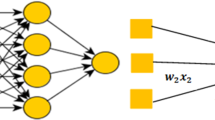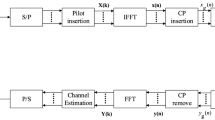Abstract
In order to increase the transceiver performance in frequency selective fading channel environment, orthogonal frequency division multiplexing (OFDM) system is used to combat inter-symbol-interference. In this work, a channel estimation scheme for an OFDM system in the presence of sparse multipath channel is studied using the artificial neural networks (ANN). By means of ANN’s learning capability, it is shown that how to model and obtain a channel estimate and how it allows the proposed technique to give a better system throughput. The performance of proposed method is compared with the Matching Pursuit (MP) and Orthogonal MP (OMP) algorithms that are commonly used in compressed sensing literature in order to estimate delay locations and tap coefficients of a sparse multipath channel. In this work, we propose a performance- efficient ANN based sparse channel estimator with lower computational cost than that of MP and OMP based channel estimators. Even though there is a slight performance lost in a few simulation scenarios in which we have lower computational complexity advantage, in most scenarios, our computer simulations corroborate that our low complexity ANN based channel estimator has better mean squared error and the corresponding symbol error rate performances comparing with MP and OMP algorithms.








Similar content being viewed by others
References
Schreiber, W. F. (1995). Advanced television systems for terrestrial broadcasting: Some problems and some proposed solutions. Proceedings of the IEEE, 83(6), 958–981.
Coleri, S. Ergen, M. & and, A. P. (2002) A study of channel estimation in ofdm systems. In Proceedings IEEE 56th Vehicular Technology Conference, (vol. 2, pp. 894–898).
Cotter, S. F., & Rao, B. D. (2002). Sparse channel estimation via matching pursuit with application to equalization. IEEE Transactions on Communications, 50(3), 374–377.
Donoho, D. L. (2006). Compressed sensing. IEEE Transactions on Information Theory, 52(4), 1289–1306.
Tian, L., & Su, Z. (2017) An estimation algorithm of time-varying channels in the ofdm communication system. In 2017 13th International Conference on Natural Computation, Fuzzy Systems and Knowledge Discovery (ICNC-FSKD), (pp. 1900–1904).
Zhang, M., Zhou, X., & Wang, C. (2019). A novel noise suppression channel estimation method based on adaptive weighted averaging for ofdm systems. Symmetry—Open Access Journal, 11(8), 1–20.
Bajwa, W. U., Haupt, J., Sayeed, A. M., & Nowak, R. (2010). Compressed channel sensing: A new approach to estimating sparse multipath channels. Proceedings of the IEEE, 98(6), 1058–1076.
Sharp, M. & Scaglione, A. (2008). Application of sparse signal recovery to pilot-assisted channel estimation. In 2008 IEEE International Conference on Acoustics, Speech and Signal Processing, (pp. 3469–3472).
Taşpınar, N., & Şimşir, Ş. (2018). Pilot tones design using particle swarm optimization for ofdm–idma system. Neural Computing and Applications.
Tang, R., Zhou, X., & Wang, C. (2018). A haar wavelet decision feedback channel estimation method in ofdm systems. Applied Sciences, 8, 1–20.
Uwaechia, A. N., & Mahyuddin, N. M. (2018). Stage-determined matching pursuit for sparse channel estimation in ofdm systems. IEEE Systems Journal, (pp. 1–12).
Gui, G., Wan, Q., Peng, W., & Adachi, F. (2010). Sparse multipath channel estimation using compressive sampling matching pursuit algorithm. arXiv e-prints. arXiv:1005.2270.
Needell, D., & Tropp, J. (2009). Cosamp: Iterative signal recovery from incomplete and inaccurate samples. Applied and Computational Harmonic Analysis, 26(3), 301–321.
Liu, J., Jin, X., Dong, F., He, L., & Liu, H. (Jul 2017). Fading channel modelling using single-hidden layer feedforward neural networks. Multidimensional Systems and Signal Processing, 28(3), 885–903.
Hussain, A., Sohail, M. F., Alam, S., Ghauri, S.A., & Qureshi, I. M. (2018) Classification of m-qam and m-psk signals using genetic programming (gp). Neural Computing and Applications.
Xu, Y. Li, D. Wang, Z. Guo, Q. & Xiang, W. (2018) A deep learning method based on convolutional neural network for automatic modulation classification of wireless signals. Wireless Networks.
Hasan, A. N., & Shongwe, T. (2017). Impulse noise detection in ofdm communication system using machine learning ensemble algorithms. In International Joint Conference SOCO’16-CISIS’16-ICEUTE’16 (pp. 85–91). Cham: Springer International Publishing.
Yang, Y. Gao, F. MA, X. & Zhang, S. (2019). Deep learning-based channel estimation for doubly selective fading channels. In IEEE Wireless Communications Letters, (vol. 7, pp. 36 579–36 589).
Jiang, R. Wang, X. Cao, S. Zhao, J. & Li, X. (2019). Deep neural networks for channel estimation in underwater acoustic ofdm systems. In IEEE Access, (vol. 7, pp. 23 579–23 594).
Ye, H., Li, G. Y., & Juang, B. (2018). Power of deep learning for channel estimation and signal detection in ofdm systems. IEEE Wireless Communications Letters, 7, 114–117.
Mohanty, B., Sahoo, H., & Patnaik, B. (2018). Neural network and sparse block processing based nonlinear adaptive equalizer for mimo ofdm communication systems. In Proceedings of TENCON 2018–2018 IEEE Region 10 Conference, (pp. 224–228). Jeju: Korea.
Cheng, C., Huamg, Y., & Chen, H. (July 2019). Enhanced channel estimation in ofdm systems with neural network technologies. Soft Computing, 23, 5185–5197.
Sarwar, A. Shah, S. & Zafar, I. (2020). Channel estimation in space time block coded mimo-ofdm system using genetically evolved artificial neural network. In 17th International Bhurban Conference on Applied Sciences and Technology (IBCAST), (pp. 703–709).
Şimşir, Ş., & Taşpınar, N. (2015). Channel estimation using radial basis function neural network in ofdm-idma system. Wireless Personal Communications, 85, 1883–1893.
Cheng, C.-H., Huang, Y.-H., & Chen, H.-C. (2016). Channel estimation in ofdm systems using neural network technology combined with a genetic algorithm. Soft Computing, 20, 4139–4148.
Bagadi, K. P., & Das, S. (2013). Neural network-based adaptive multiuser detection schemes in sdma-ofdm system for wireless application. Neural Computing and Applications, 23, 1071–1082.
Liu, J., Mei, K., Zhang, X., Ma, D., & Wei, J. (2019). Online extreme learning machine-based channel estimation and equalization for ofdm systems. IEEE Communications Letters, 23(7), 1276–1279.
3GPP. (2016). 3GPP Long Term Evolution (LTE) Standard Release 10. [Online]. Available: https://www.3gpp.org/specifications/releases/70-release-10
Şenol, H. (2015). Joint channel estimation and symbol detection for ofdm systems in rapidly time-varying sparse multipath channels. Wireless Personal Communications, 82(3), 1161–1178.
Funding
Not Applicable
Author information
Authors and Affiliations
Corresponding author
Ethics declarations
Conflicts of interest
The authors declare that they have no conflict of interest.
Additional information
Publisher's Note
Springer Nature remains neutral with regard to jurisdictional claims in published maps and institutional affiliations.
Rights and permissions
About this article
Cite this article
Senol, H., Bin Tahir, A.R. & Özmen, A. Artificial neural network based estimation of sparse multipath channels in OFDM systems. Telecommun Syst 77, 231–240 (2021). https://doi.org/10.1007/s11235-021-00754-5
Accepted:
Published:
Issue Date:
DOI: https://doi.org/10.1007/s11235-021-00754-5




